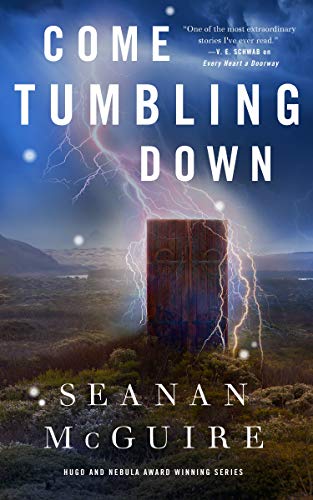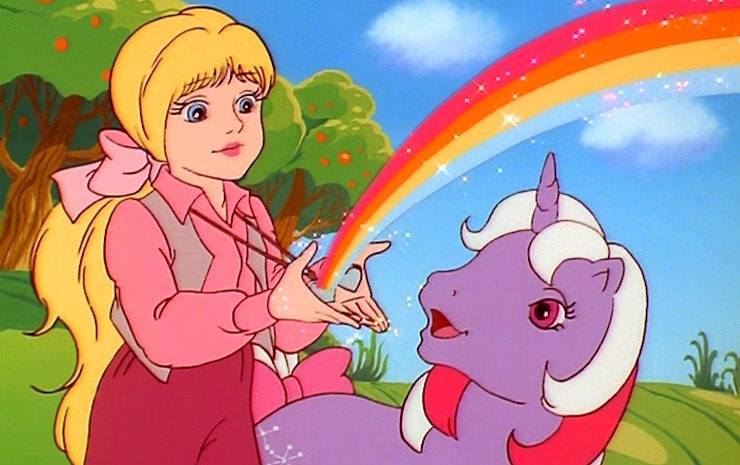I don’t have many memories from before I was six. I don’t think most people do. We have the idea of memories, the stories our families have told us about how cute we were when we were little, the ridiculous things we did or said or believed. It seems weird to me sometimes that I could have forgotten the things people tell me happened, like the time I brought a rattlesnake home to be my new pet, or the time I spent an entire summer taking naps on top of bookcases, but that’s the thing about human memory. It doesn’t play fair.
One of those early memories, though, one of those rare, precious, treasured memories, is walking through a department store with my grandmother. I was four. She was taking me to get a present. I’m not sure why: it may have had something to do with my mother’s impending marriage to the man who would go on to father my two sisters, or maybe she just felt like it. Whatever the reason, she took me to the toy section and told me I could have two things.
I picked Minty and Cotton Candy, two of the original six My Little Ponies, and thus was an obsession born.
These days, the phrase “My Little Pony” is often followed with “friendship is magic,” or an enthusiastic discussion of the Brony phenomenon. But this was the 1980s. My Little Ponies were “girl toys,” sneered at by boys on the playground (even the ones who would happily play with me when we were all at home), embraced by parents for their—at least initial—lack of all Barbie’s easily lost accessories. They were candy-colored horses living in a harmless fantasyland. They didn’t have little plastic shoes to step on in the middle of the night; they didn’t require batteries or complicated assembly. They were perfect.
I thought so too. Very quickly, I had the original six, and then, when they started releasing unicorns and pegasi and sea ponies, I had a whole herd. It kept growing. Every holiday, I asked for Ponies. I got them in my Easter basket and as gifts on Valentine’s Day. When my first sister was born, I got the Dream Castle to distract me from the way the baby howled in the middle of the night. I saved my birthday and Christmas money, spending it on, yes, more Ponies. (I also spent it on books. But Ponies came out at a regulated pace, so it was possible to get both, if I was clever.)
Again, this was the 1980s, the great era of thirty-minute commercials disguised as children’s programming. G.I. Joe, the Transformers, they all had cartoons… and the properties intended for boys1 had network censors on hand, making sure that no one ever actually got shot or died. War was intended to be another form of play, and the closest we saw to a fatality was the horrific mutation of a few side characters on Teenage Mutant Ninja Turtles or The Inhumanoids.
Cartoons that were assumed to have an all-female audience, on the other hand, needed less supervision. I mean, how violent could a show about talking horses with magical powers and flowers on their butts really get?
Oh. Oh, those poor fools.
In the very first animated adventure of the Ponies, they fought the Devil. Like, the Devil. He wanted to transform innocent Ponies into dragons of darkness and use them to bring about eternal night, as one does. Lots of Pony panic and some casual kidnapping followed, and something in my tiny blonde brain went “click.”
You could get away with anything, if you made it fluffy and pink enough. You could destroy the whole world, as long as you were willing to cover it in glitter first.
Oh, this was going to be fun.
My Ponies—which, by this point, filled most of my bedroom at any given time, since I would build them cities out of playsets combined with cardboard boxes that I had modified to suit my needs—began a multi-generational saga of false queens, royal espionage, forgotten princesses, kidnappings, murders, and a thousand other things that no one really wants to think about seven-year-old girls playing out in their spare time…and yet. Majesty (the Queen of the Ponies according to the official playline) ruled from the Dream Castle with an iron hoof, cruel and unforgiving, while Moondancer and her rebel army struggled to put the true heir, Powder, on the throne. Sometimes Ponies died, and would go into the box in the closet for a few months before they were repurposed with a new identity and a new role in the ongoing game.
Buy the Book


Come Tumbling Down
Basically, for me, My Little Pony was Gormenghast with hooves. I can still remember so many of my storylines … and I can see where I have repurposed them for my adult work. Seashell, for example, one of only two sitting Ponies ever made, was a sea witch who couldn’t lie, and who could do almost anything she was asked, for a price. Sound familiar? (If it doesn’t, that’s basically the Luidaeg from my October Daye books.) I was learning to tell stories by telling them to myself, and my Ponies were the avatars of everything I created.
When I was twelve, people stopped buying me Ponies because I was “too old” for them. I kept buying them for myself, but it wasn’t the same, and I couldn’t keep up. By the time the toy line was discontinued for the first time, I was in high school. I barely noticed. But I still had, and treasured, all my Ponies.
Then, when I was fifteen, we lost our apartment, and I went to live with friends. A year later, at sixteen, we lost our storage unit for non-payment, and I lost all my Little Ponies. I was honestly more heartbroken by that than I was by losing anything else.
A few years later, eBay came along.
I still collect My Little Ponies. I’m still in the process of rebuilding my childhood collection. I can’t always separate what I actually had from what I just wanted so badly that I remember them as if I owned them, but I don’t actually care all that much, because I am a grownup now, and I get to make my own choices, and what I choose is to devote a terrifying amount of space to little plastic horses that taught me how to tell a story and still mean the world to me. I love them very much, small and strange and technically useless as they are. After all, they’re the ones who first asked me the question that has defined most of my life, weirdly enough:
What will today’s adventure be?
Top image: My Little Pony: Escape From Catrina (Sunbow Productions / Marvel Productions)
This article was originally published in January 2017 as part of our “Related Subjects” series.
Seanan McGuire is the author of the October Daye urban fantasy series, the InCryptid series, and several other works, both standalone and in trilogies. She lives in a creaky old farmhouse in Northern California, and was the winner of the 2010 John W. Campbell Award for Best New Writer. In 2013 she became the first person ever to appear fives times on the same Hugo ballot. The Wayward Children novella series —Every Heart a Doorway, Down Among the Sticks and Bones, Beneath the Sugar Sky, In an Absent Dream, and the forthcoming Come Tumbling Down—is available from Tor.com Publishing.
[1]Children’s toys have been increasingly binary in nature since the 1970s, and the 80s were really the beginning of what we sometimes refer to as “the pinkification” of the girls’ section of the toy store. There were girls who liked Transformers and boys who liked Ponies, but the commercials and cartoons were very firm on who those things were for. This impacted all aspects, from advertisement to script supervision, and cannot be divorced from any look at the history of the brand, however nostalgic.)











Another amazing novella from Tor is available for free! You won’t regret downloading this story!!!
*Sigh*
“This Special Offer is open only to persons who are a legal resident of the 50 United States, the District of Columbia or Canada (excluding Quebec)”
Please stop telling me about things I can’t have